The Pioneer Power Meter entered the cycling scene a few years ago, a surprising move from a company primarily known for audio-visual technology. Initially met with skepticism, Pioneer has persevered, refining their product and making a significant impact on the market.
Their first attempt at a power meter was notoriously difficult to install, requiring expert technical skills. However, Pioneer listened to feedback and released a second-generation unit that dramatically simplified installation and improved accessibility. More recently, Pioneer made waves by drastically reducing prices, positioning themselves as offering exceptional value in the power meter market. Adding to their appeal, they’ve also introduced a left-leg only option in certain regions at an even more competitive price point. Pioneer has also indicated future developments for their product line, signaling their continued commitment to cycling technology.
This review will delve into the second-generation Pioneer power meter, the model currently available at a compelling price of $999 USD. Pioneer provided a test bike with the power meter pre-installed. This reflects their intended sales model, where consumers are expected to purchase and have the power meter installed via their local bike shop.
After completing this review, the test bike will be returned to Pioneer’s offices.
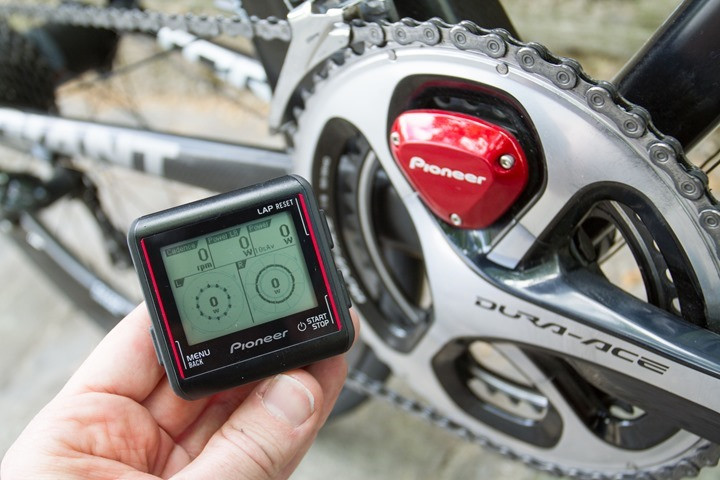 Pioneer Power Meter System
Pioneer Power Meter System
Pioneer Power Meter: Key Features and Design
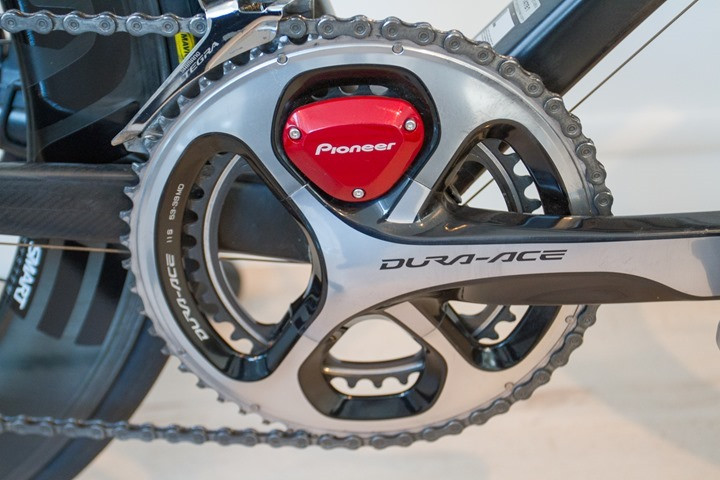 Pioneer Power Meter Components
Pioneer Power Meter Components
As the test unit was pre-installed, direct experience with the installation process is limited. However, installing power meters in general often highlights frame compatibility as a key consideration. This is especially true for crank-based power meters with internal electronics, where clearance with the bike frame can be an issue.
The Pioneer system utilizes magnets on both crank arms, attached to the bike frame. While some newer power meters are moving towards accelerometer-based cadence measurement, magnets offer advantages, particularly in high cadence scenarios (170RPM+) and potentially in mitigating vibration-related accuracy issues. While vibration issues are now rare due to improved algorithms in modern power meters, magnets can still provide a robust cadence measurement.
The magnets are discreetly positioned on the frame.
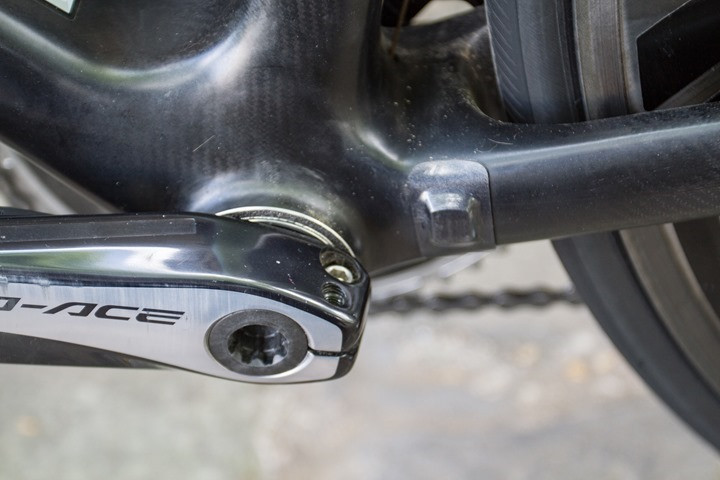 Pioneer Power Meter Magnet Placement on Frame
Pioneer Power Meter Magnet Placement on Frame
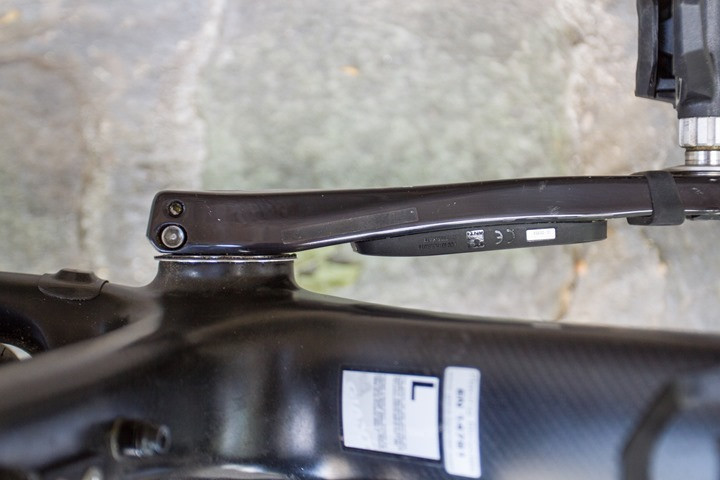 Close-up of Pioneer Power Meter Magnet
Close-up of Pioneer Power Meter Magnet
The core of the Pioneer power meter is located on the crank arms themselves, just beyond the magnets. This is where the force exerted on the cranks is measured. Combined with cadence data from the magnets, the system calculates power output. Being a dual-leg power meter, sensors are present on both crank arms. This independent measurement of each leg allows for detailed left/right power balance data, contributing to a comprehensive power profile.
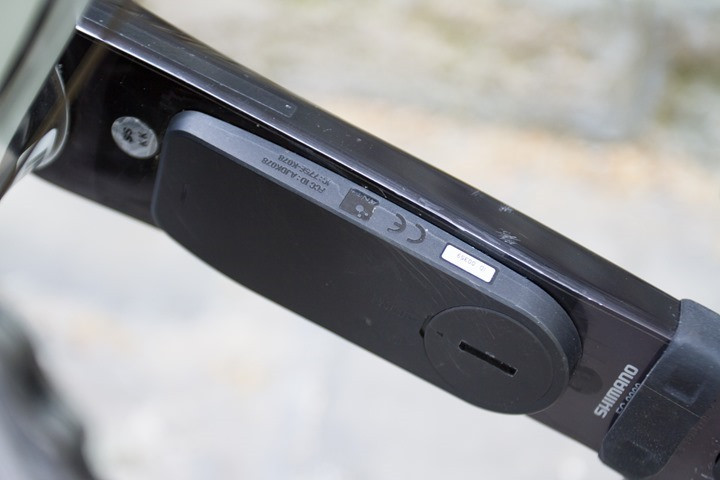 Pioneer Power Meter Sensor on Crank Arm – Left Side
Pioneer Power Meter Sensor on Crank Arm – Left Side
 Pioneer Power Meter Sensor on Crank Arm – Right Side
Pioneer Power Meter Sensor on Crank Arm – Right Side
On the drive side crank arm, a pod houses the battery and a button.
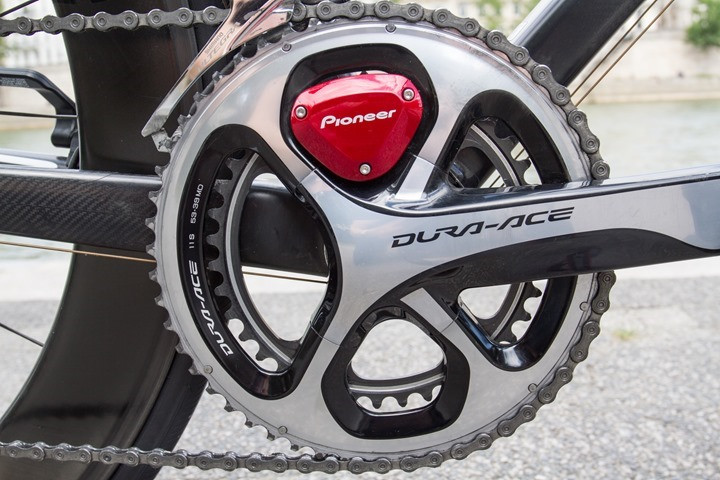 Pioneer Power Meter Pod on Drive Side
Pioneer Power Meter Pod on Drive Side
Opening the pod reveals the battery and a button that controls features like manual magnet recalibration and transmission mode switching between private ANT and ANT+.
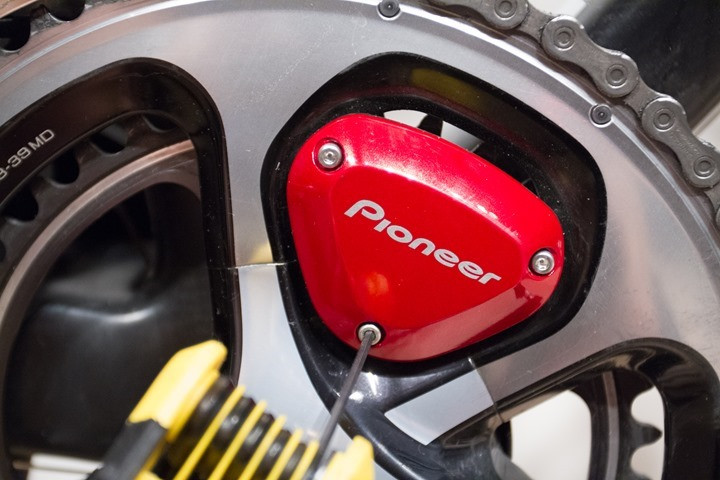 Pioneer Power Meter Pod Open – Battery and Button
Pioneer Power Meter Pod Open – Battery and Button
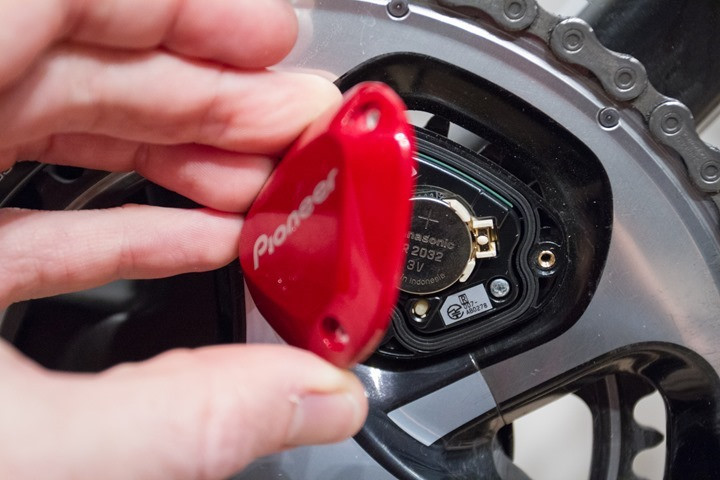 Pioneer Power Meter Button Detail
Pioneer Power Meter Button Detail
A forthcoming firmware update for the Pioneer head unit will enable transmission mode switching directly from the head unit, eliminating the need to access the button on the pod.
 Pioneer Head Unit Display
Pioneer Head Unit Display
Riders have the option to pair the Pioneer power meter with either a Pioneer head unit or a third-party head unit. Calibration, which includes both zero offset and force validation, can be performed through either type of head unit. The Pioneer head unit uniquely saves manual calibration data along with temperature readings, accessible via their online portal.
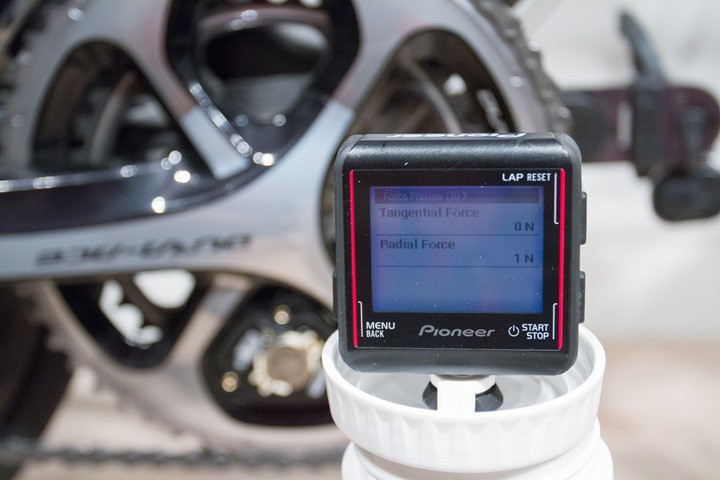 Pioneer Head Unit Calibration Options
Pioneer Head Unit Calibration Options
Calibration options within the Pioneer head unit menu include zero offset and force calibration.
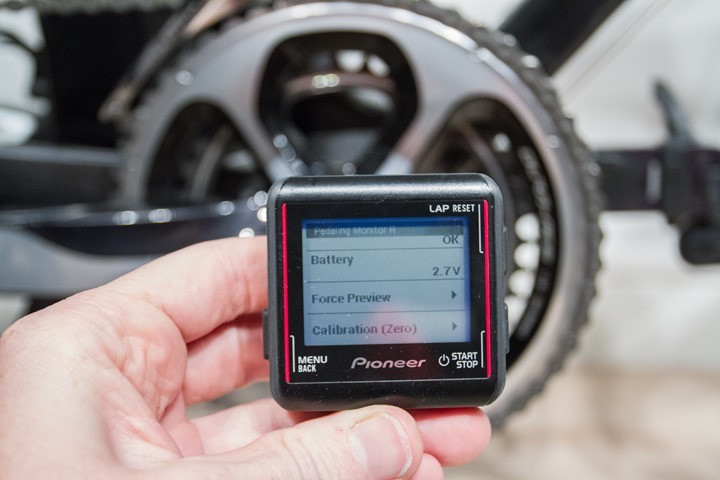 Pioneer Head Unit Calibration Menu
Pioneer Head Unit Calibration Menu
Pioneer Bike Computer (Head Unit) Review
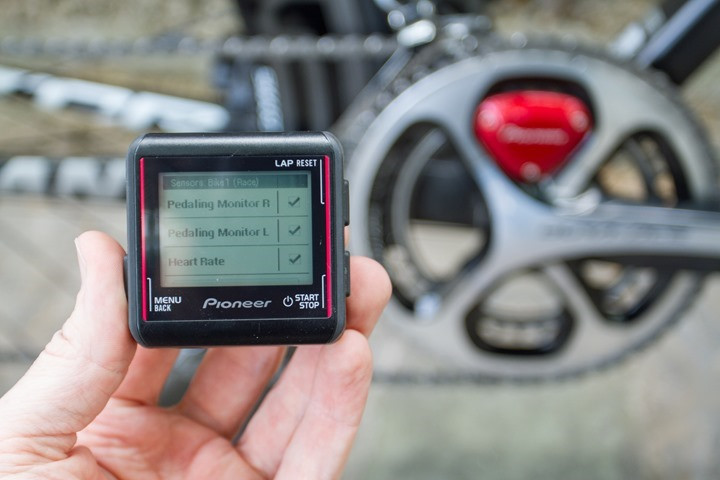 Pioneer SGX-CA500 Bike Computer
Pioneer SGX-CA500 Bike Computer
Pioneer offers its own bike computers designed to complement their power meters. The tested unit was the SGX-CA500, a model with a similar depth to the Garmin Edge 500 but slightly wider, featuring a squared-off design.
 Pioneer SGX-CA500 Side View
Pioneer SGX-CA500 Side View
 Pioneer SGX-CA500 Front View
Pioneer SGX-CA500 Front View
Weighing in at 74g, the Pioneer head unit is competitively light.
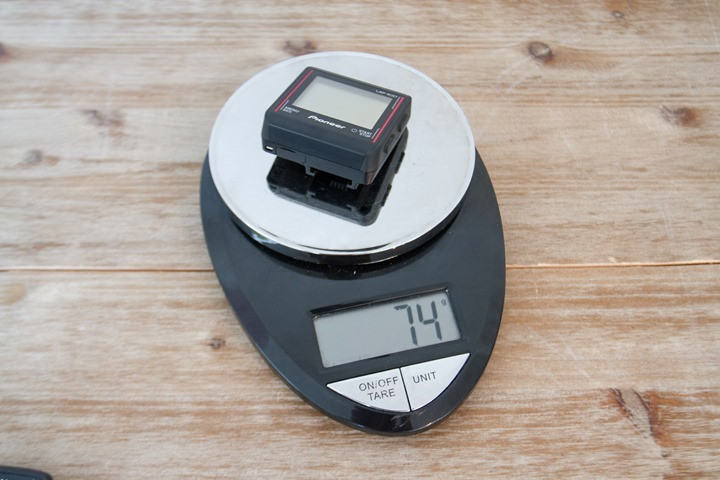 Pioneer SGX-CA500 Weight Measurement
Pioneer SGX-CA500 Weight Measurement
Compared to other bike computers, the weight is in a similar range:
- Edge 500: 57g
- Edge 510: 81g
- Edge 810: 98g
- Edge 1000: 114g
Unlike the older Edge 500, the Pioneer SGX-CA500 includes features like WiFi uploads and a touchscreen display, along with a larger screen. However, its standout feature is its ability to record high-precision torque analysis data from Pioneer power meters. This detailed data, transmitted via a private ANT channel, is exclusive to Pioneer head units and provides insights into power application throughout the pedal stroke. The torque display visualizes where power is generated in the pedal cycle.
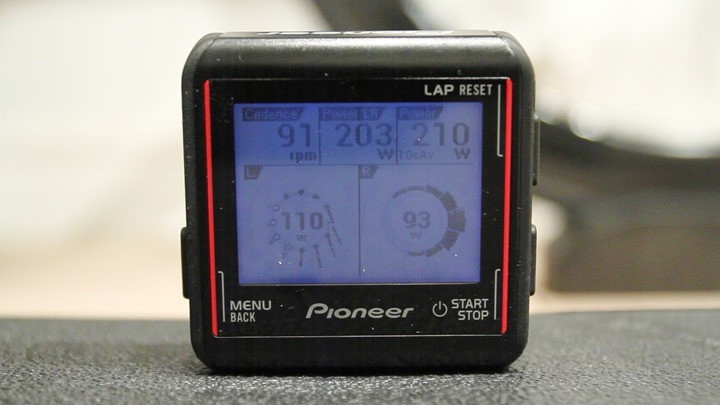 Pioneer Head Unit Torque Analysis Display – Pedal Stroke Visualization
Pioneer Head Unit Torque Analysis Display – Pedal Stroke Visualization
The display can be customized to show torque analysis for individual legs. In normal pedaling, power is predominantly shown on the downstroke.
In a single-leg pedaling drill, the display demonstrates increased force during the upstroke as the rider actively pulls up to maintain pedal rotation.
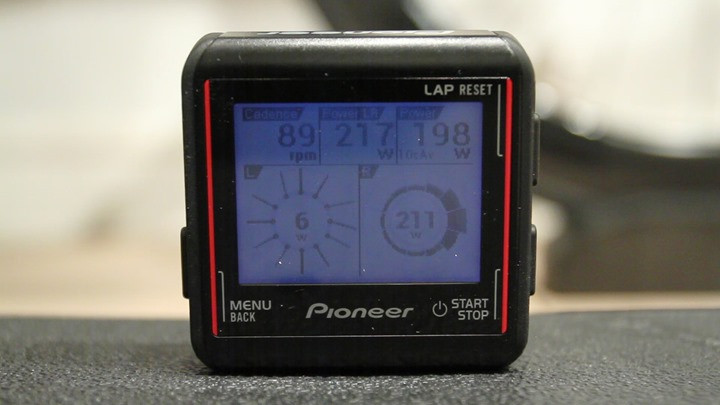 Pioneer Head Unit Torque Analysis Display – Single Leg Pedaling
Pioneer Head Unit Torque Analysis Display – Single Leg Pedaling
This torque analysis functionality is akin to Garmin’s Cycling Dynamics, specifically the power phase component, but Pioneer pioneered this technology years earlier. The purpose of this data is to identify and improve “dead spots” in the pedal stroke, theoretically leading to increased power output. However, focusing too much on technique can sometimes disrupt natural power generation. The unit captures data every 30 degrees of crank rotation, resulting in a high data sampling rate (12 times per second at 60RPM) when paired with a Pioneer head unit.
The Pioneer head unit offers a wide array of data metrics and customizable data screen layouts.
Data screen examples showcasing customizable metrics
Data screen examples showcasing customizable metrics
Data screen examples showcasing customizable metrics
Data screen examples showcasing customizable metrics
Data screen examples showcasing customizable metrics
Data screen examples showcasing customizable metrics
GPS Accuracy:
The GPS performance of the Pioneer head unit is comparable to other cycling GPS devices, providing accurate tracking.
Ride examples are available for interactive map analysis:
Ride 1: Longchamp Loops: Longchamp Ride GPS Data
Ride 2: Cross-town Ride: City Ride GPS Data
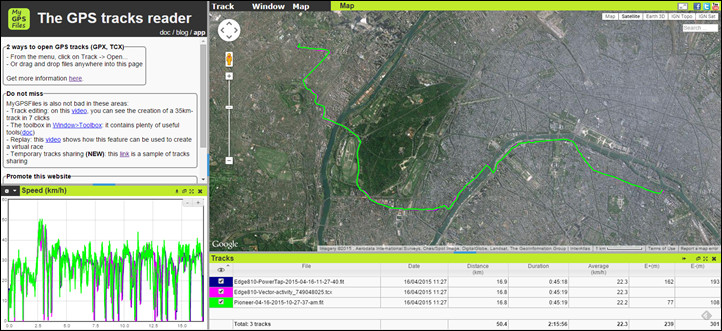 Cross-town Ride Map
Cross-town Ride Map
Ride 3: 70 Minute Ride to Versailles: Versailles Ride GPS Data
While GPS tracking is generally reliable, occasional minor deviations may occur, as with any GPS unit.
A brief video demonstrates the user interface and some key functionalities of the Pioneer head unit:
 Pioneer Head Unit UI Demo Video
Pioneer Head Unit UI Demo Video
Activity uploads can be performed via WiFi to Pioneer’s Cyclo-Sphere platform, which then syncs with services like Strava and Training Peaks. Alternatively, connecting via micro-USB allows uploads using device agent software. This software is required as the head unit doesn’t natively produce .FIT files. However, .FIT files can be exported from the Cyclo-Sphere website after upload.
While the core functionalities are present, the user experience of the head unit lacks polish. Touchscreen responsiveness can be slow and inconsistent, and the user interface isn’t always intuitive. Navigating menus and settings can be cumbersome.
Furthermore, the head unit lacks structured workout features, smartphone pairing, on-device mapping, or course navigation.
For mounting, a K-Edge mount was used and proved to be robust. While the included plastic mount is functional, the K-Edge offers a more secure feel. Pioneer includes a tether as a precaution with their standard mount.
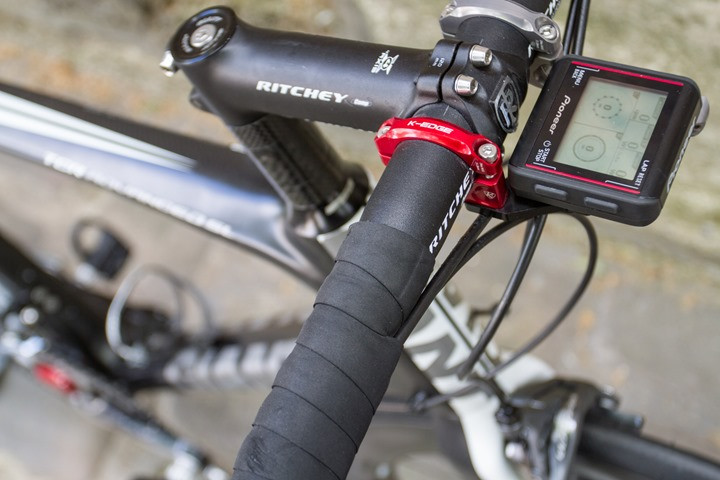 Pioneer Head Unit on K-Edge Mount
Pioneer Head Unit on K-Edge Mount
 Pioneer Head Unit Mount Detail
Pioneer Head Unit Mount Detail
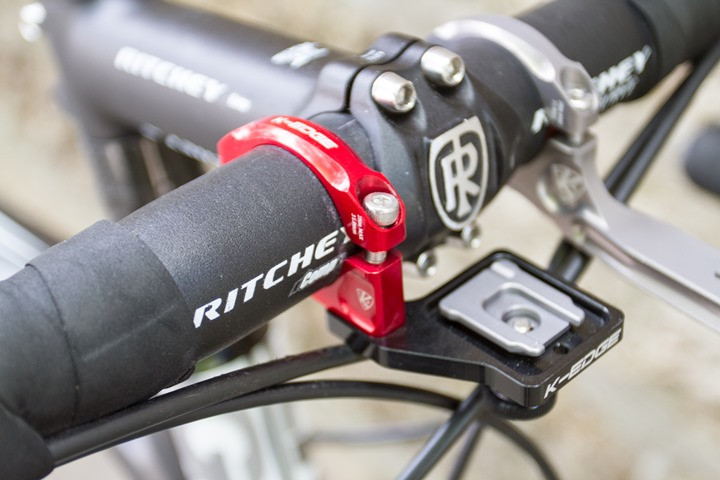 Pioneer Head Unit Mounted on Handlebars
Pioneer Head Unit Mounted on Handlebars
In summary, the Pioneer head unit is functional but less compelling than other options unless the torque analysis data is a priority. For users not needing this advanced metric, more feature-rich and user-friendly bike computers are available at similar or lower prices.
3rd Party Head Unit Compatibility
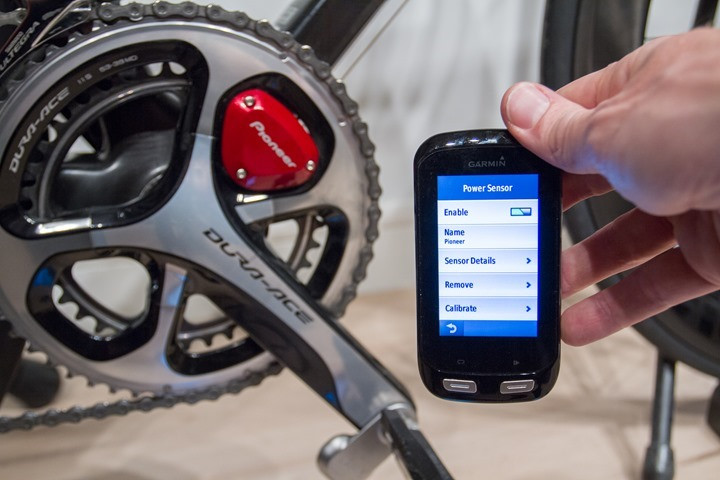 Pioneer Power Meter ANT+ Compatibility
Pioneer Power Meter ANT+ Compatibility
The Pioneer power meter supports two transmission modes: ANT+ and private-ANT. In ANT+ mode, it broadcasts standard power meter data compatible with any ANT+ enabled head unit. Private-ANT mode, a proprietary variant, is necessary to access the advanced torque analysis data and is exclusive to Pioneer head units.
Switching between modes is done via a button located within the pod, near the battery.
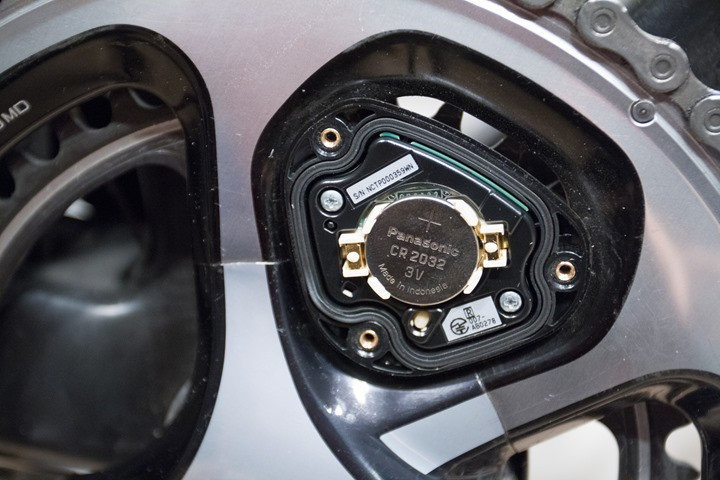 Pioneer Power Meter Transmission Mode Button Location
Pioneer Power Meter Transmission Mode Button Location
A future firmware update will allow mode switching directly from the Pioneer head unit. Currently, dual transmission (broadcasting both ANT+ and private-ANT simultaneously) is not supported. Dual transmission would offer maximum flexibility, allowing for both advanced data capture on a Pioneer head unit and compatibility with other devices.
In ANT+ mode, the Pioneer power meter transmits:
- Total Power
- Left/Right Power Balance
- Cadence
Initially, standard ANT+ metrics like Torque Effectiveness and Pedal Smoothness were not transmitted, but a firmware update in May 2017 added these features.
Testing was conducted with both ANT+ head units (primarily Garmin) and the Pioneer head unit. Pairing with a Garmin Edge 1000 is straightforward.
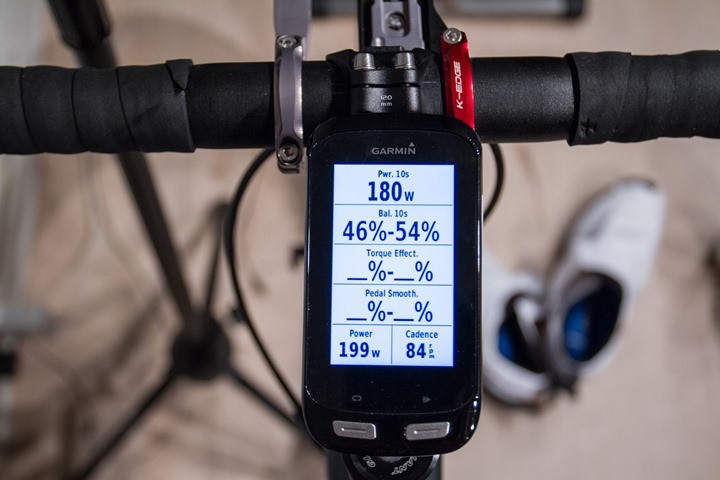 Pioneer Power Meter Paired with Garmin Edge 1000
Pioneer Power Meter Paired with Garmin Edge 1000
Data consistency is maintained across different ANT+ head units, from basic models like the Garmin Edge 500 to more advanced units.
Garmin Cycling Dynamics data will not be displayed on Garmin devices when paired with the Pioneer power meter. This is due to Garmin’s proprietary data channel, mirroring Pioneer’s approach with their torque analysis data.
Power Meter Accuracy Testing
Power meter accuracy is crucial. To assess the Pioneer power meter’s accuracy, data was collected from multiple rides, comparing it against a PowerTap G3 hub-based power meter and Garmin Vector pedal-based power meter.
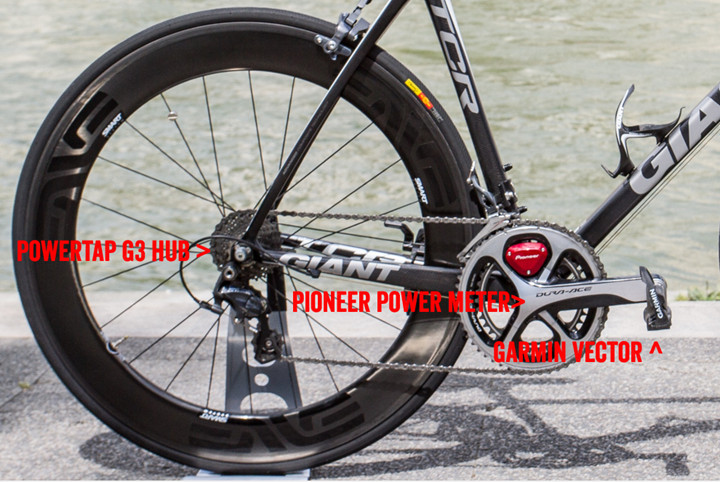 Power Meter Accuracy Comparison Graph Example
Power Meter Accuracy Comparison Graph Example
While real-time ANT+ data capture via a WASP system wasn’t possible in private-ANT mode, data was exported from the Pioneer website in .FIT format for analysis.
The accuracy assessment included outdoor rides and indoor trainer sessions, as well as cadence sweep tests. While extensive data was collected, a representative subset is presented here.
Ride 1: Longchamp Loops Accuracy Test
This ride consisted of city riding and consistent power loops in a park popular with cyclists, including occasional sprints.
Average and Max Power comparison:
- PowerTap G3: 165/881w
- Garmin Vector: 173w/891w
- Pioneer Power: 152.5w/794.2w
Smoothed power data (10-second and 30-second averages) show good correlation between PowerTap and Pioneer, with Garmin Vector reading slightly higher, which is typical in power meter comparisons.
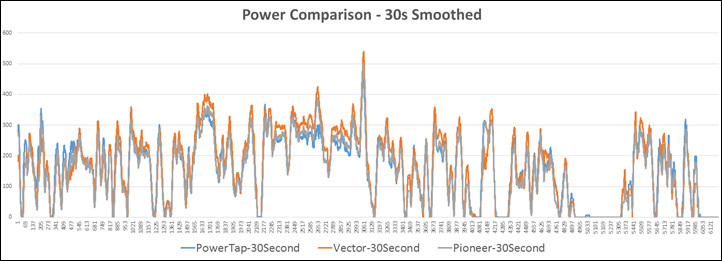 Power Meter 30-Second Smoothed Power Comparison Graph
Power Meter 30-Second Smoothed Power Comparison Graph
Ride 2: Versailles Ride Accuracy Test
This ride included varied terrain, from riverside paths to wooded climbs en route to Versailles.
Average and Max Power comparison:
- PowerTap G3: 181w/818w
- Garmin Vector: 197w/805w
- Pioneer Power: 179.4/772.4w
Smoothed power data again shows excellent agreement between all three power meters throughout the ride.
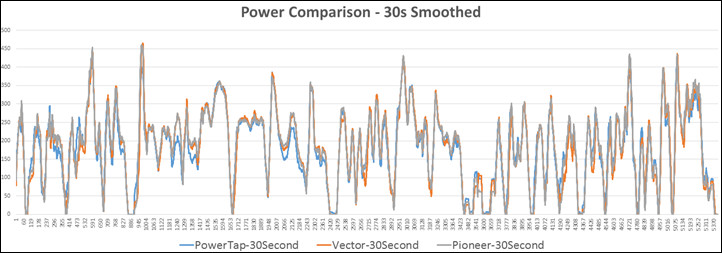 Power Meter 30-Second Smoothed Power Comparison Graph
Power Meter 30-Second Smoothed Power Comparison Graph
Minor discrepancies, common in power meter comparisons, are mainly observed during start/stop periods due to variations in data reporting and recording timing.
Ride 3: Trainer Ride Accuracy Test
Indoor trainer rides provide a controlled environment for accuracy testing. This session included varying power and cadence ranges, one-leg drills, high-cadence segments (150RPM), and 30×30 intervals.
Average and Max Power comparison:
- PowerTap G3: 201w/470w
- Garmin Vector: 204w/480w
- Pioneer Power: 199w/439w
Smoothed power data demonstrates consistent tracking across all three units during the trainer session.
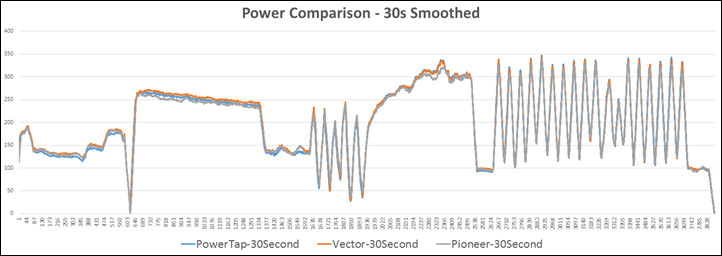 Power Meter 30-Second Smoothed Power Comparison Graph
Power Meter 30-Second Smoothed Power Comparison Graph
Overall accuracy testing indicates the Pioneer power meter performs reliably and consistently aligns with other power meters. Cadence measurement, utilizing magnets, is also accurate and consistent.
Raw data files used in accuracy testing.
Pioneer Cyclo-Sphere Website Platform
The Pioneer Cyclo-Sphere website serves as the data analysis platform for Pioneer devices. While powerful in its data presentation, the website’s user interface and design feel dated.
The Cyclo-Sphere dashboard provides an overview of uploaded activities.
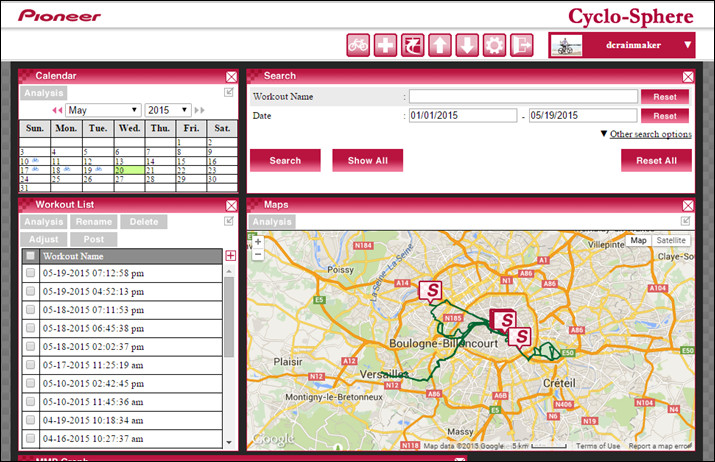 Cyclo-Sphere Dashboard Screenshot
Cyclo-Sphere Dashboard Screenshot
Workout analysis requires selecting activities and then clicking “Analysis.” Navigation and workflow on the site can be less intuitive. Once in a workout, data is displayed with various metrics and graphs.
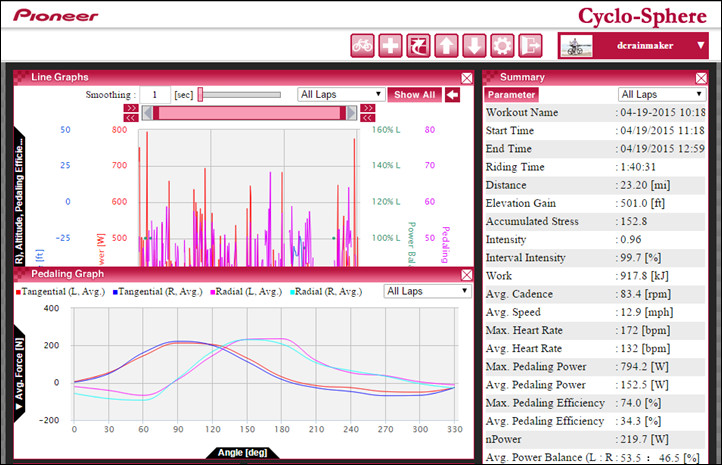 Cyclo-Sphere Workout Analysis Screenshot 1
Cyclo-Sphere Workout Analysis Screenshot 1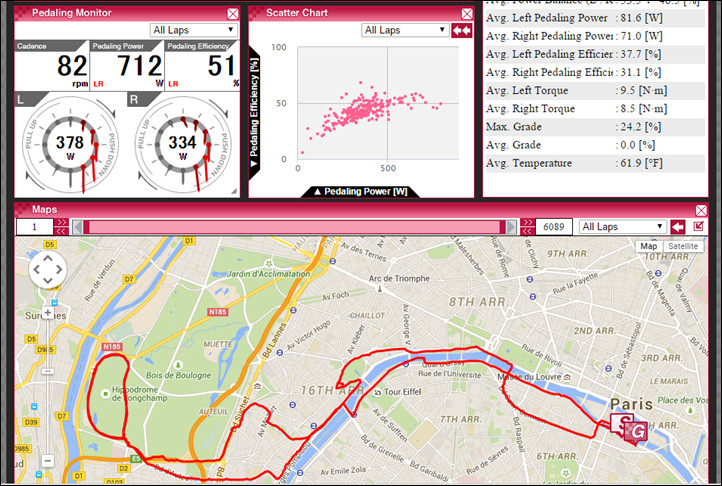 Cyclo-Sphere Workout Analysis Screenshot 2
Cyclo-Sphere Workout Analysis Screenshot 2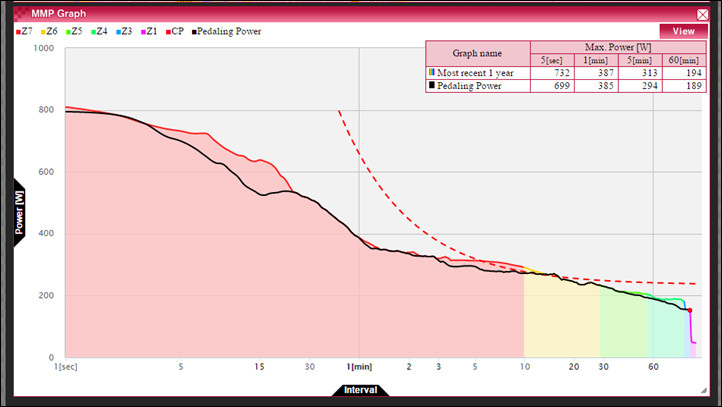 Cyclo-Sphere Workout Analysis Screenshot 3
Cyclo-Sphere Workout Analysis Screenshot 3
Users can customize graphs, adjust smoothing, and analyze specific laps.
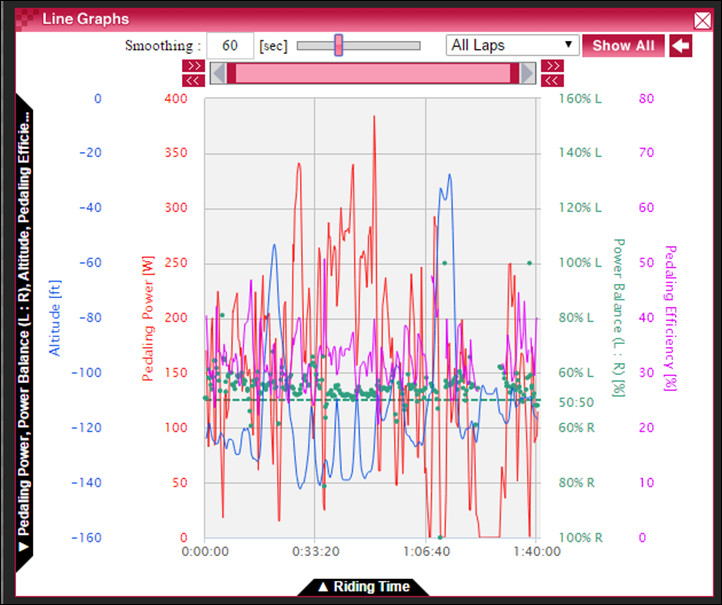 Cyclo-Sphere Graph Customization Options
Cyclo-Sphere Graph Customization Options
Widgets can be rearranged and customized to display various metrics, including scatter charts with adjustable axes.
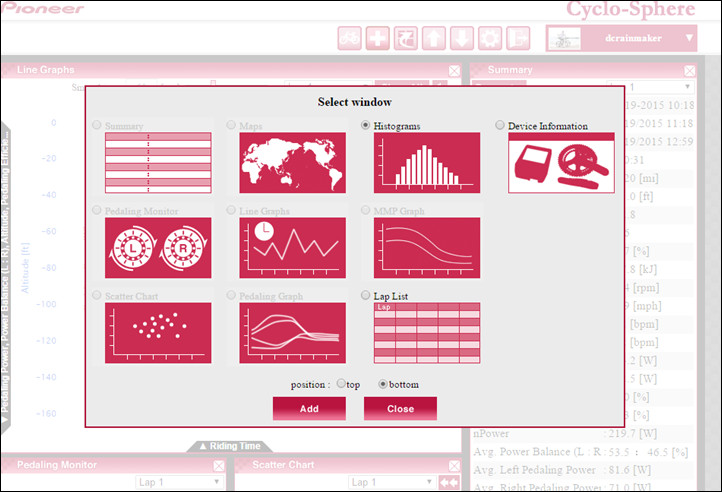 Cyclo-Sphere Customizable Widgets
Cyclo-Sphere Customizable Widgets
Website settings allow for customization of display formats and advanced options like power recalculation, useful for correcting data anomalies. Detailed information on power recalculation is available in their FAQ.
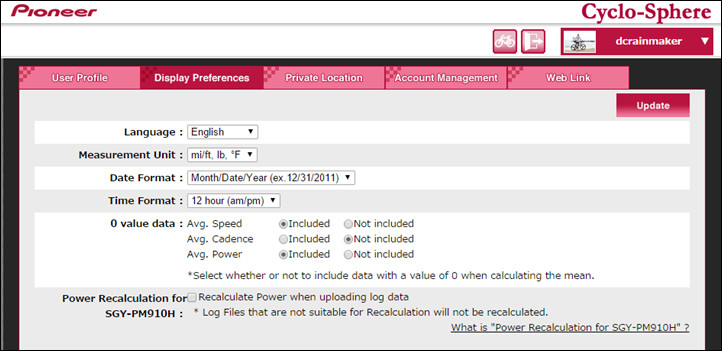 Cyclo-Sphere Settings Menu
Cyclo-Sphere Settings Menu
Direct synchronization with third-party platforms like TrainingPeaks is supported.
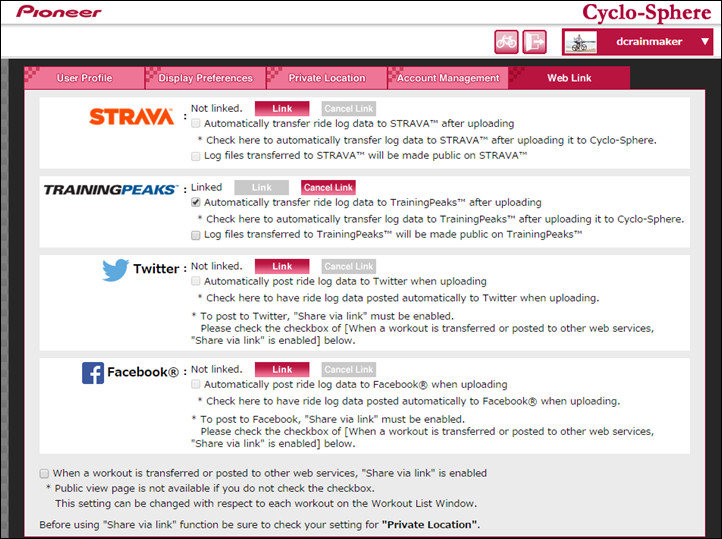 Cyclo-Sphere 3rd Party Sync Options
Cyclo-Sphere 3rd Party Sync Options
However, privacy settings and workout sharing are complex and convoluted compared to other platforms. Sharing a workout requires multiple steps to generate a shareable link, such as this example.
While data analysis capabilities are robust, the Cyclo-Sphere website suffers from usability issues, slow loading times, and a dated design. Pioneer has acknowledged these shortcomings and is reportedly working on improvements.
Firmware Updates and Future Plans
Firmware updates for Pioneer head units can be performed via WiFi or USB. While WiFi updates can be unreliable and lack progress indicators, USB updates are generally successful.
 Pioneer Firmware Update Menu Screenshot
Pioneer Firmware Update Menu Screenshot
Despite occasional update challenges, Pioneer regularly releases firmware updates, demonstrating ongoing product support and feature enhancements.
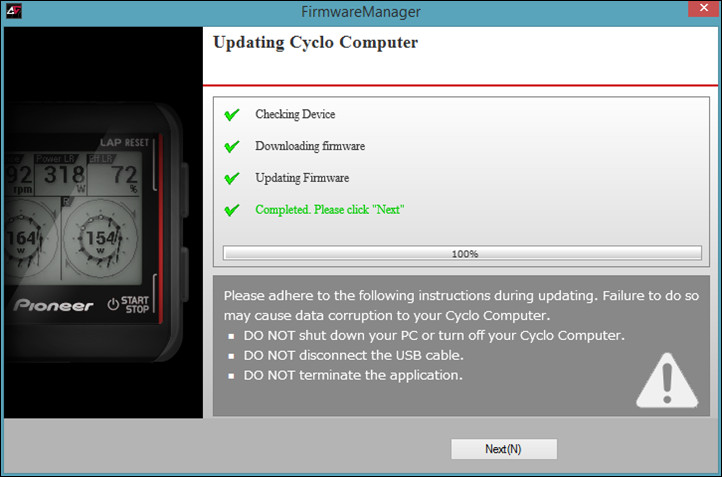 Pioneer Firmware Update Successful Screenshot
Pioneer Firmware Update Successful Screenshot
Pioneer has announced several upcoming updates and product adjustments:
Upcoming Updates:
- Modified transmitter mount for improved frame clearance, particularly for Pinarello F8 and Trek Émonda bikes.
- Flattened left-side battery cap for increased clearance on Wilier Cento 1 SR bikes.
- Firmware update to enable ANT/ANT+ transmission mode switching via the SGX-CA500 head unit.
- Planned website updates for Cyclo-Sphere (details unspecified).
Recently Announced Products:
- Introduction of right-only and left-only power meter options in select markets (Australia, Europe, Taiwan).
- Crank arm send-in program for single-sided power meter installation (available in most markets except Europe, which offers pre-installed left-side Ultegra crank arms).
Pioneer Power Meter Model and Pricing Overview (as of May 2015):
| Crank Type | Single or Dual | Model Name | Japan | Australia/NZ | Europe | USA | Taiwan |
|---|---|---|---|---|---|---|---|
| Send in your cranks | Left-only | SGY-PM910HL | ¥ 74,800 | $799 | – | – | Yes |
| Send in your cranks | Right-only | SGY-PM910HR | ¥ 74,800 | $799 | – | – | Yes |
| Send in your cranks | Full Left/Right | SGY-PM9100C | ¥ 129,600 | $1,399 | € 1,399 | $999 | Yes |
| Pre-installed cranks | Left-only (Ultegra) | N/A | – | – | € 799 | – | – |
| Pre-installed cranks | Left-only (DuraAce) | N/A | – | – | – | – | – |
| Pre-installed cranks | Full (Ultegra) | SGY-PM68 | – | – | – | $1,549 | – |
| Pre-installed cranks | Full (DuraAce) | SGY-PM90 | – | – | – | $1,849 | – |
Note: Pricing and availability are subject to change.
Conclusion: Pioneer Power Meter – High Value, Solid Performance
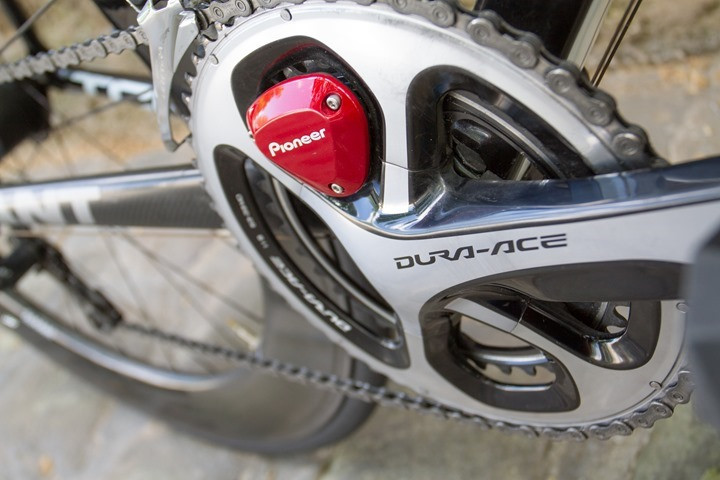 Pioneer Power Meter on Bike
Pioneer Power Meter on Bike
With its current price point, the Pioneer power meter stands out as a compelling option, especially for cyclists seeking a dual-leg measurement system under $1000. While competitors are emerging, Pioneer offers a proven, shipping product with a track record of accuracy.
Accuracy testing confirms the Pioneer power meter’s reliability, consistently aligning with other established power meters.
While the power meter system itself is recommended, the Pioneer head unit is less appealing due to its usability limitations and feature set compared to alternatives. The unique torque analysis data is interesting but may not be essential for all users. However, even without the head unit, the Pioneer power meter delivers excellent value and functionality at its price.
The ideal power meter choice depends on individual needs and bike setup. Pedal or hub-based systems offer advantages for multi-bike users, while crank-based systems like Pioneer are well-suited for single-bike setups.
Overall, the Pioneer power meter is a strong contender in the market, offering a combination of accuracy, dual-leg measurement, and competitive pricing, making it a worthwhile consideration for performance-focused cyclists.
